Super Meat Boy Dissection: Doing 8-bit with 64 bits
2011, January 22nd 5:12 PMBeen awhile since we've had one of these, eh? Let's get some images, too. Images that aren't screencaps of my own games.
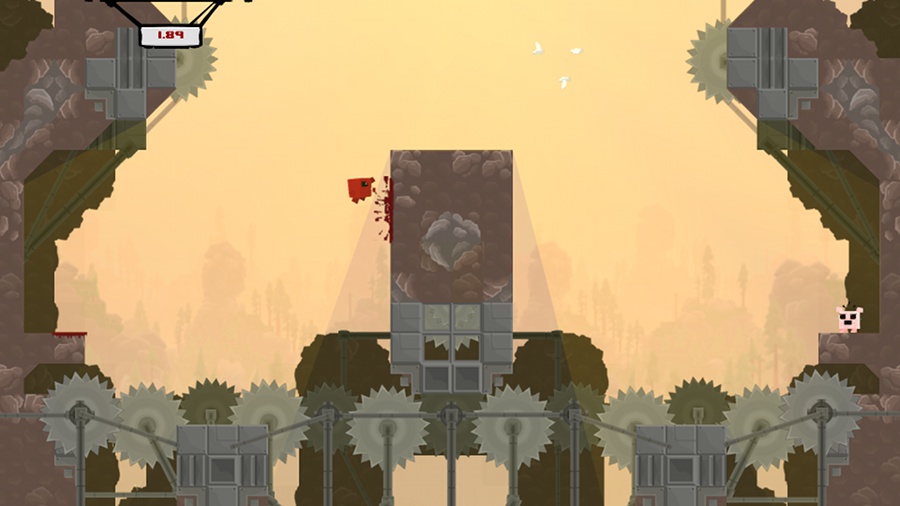
Oh man that's so much better.
Super Meat Boy is a truly fantastic indie platformer that came out a few months ago. It's available here, though if you haven't played it by now, it may not be your cup of tea.
You see, Super Meat Boy is hard. Hair-tearingly soul-crushingly ridiculously hard. It is one of the harder games that's come out in the last decade or so. What happened a decade ago? We learned that games should probably be possible.
It might not seem like we had to learn that, but, trust me, we did. For a long period of time, games weren't meant to be possible, they were meant to eat your quarters forever. The more quarters you could convince someone to feed into your arcade machine, the more money you made. This culminated with a rather notorious boss in the Dungeons and Dragons arcade machine that would literally take no damage until you'd put in twenty quarters. That's right: you have to pay five bucks to start killing the boss. Eventually games moved on to consoles and computers, and people stopped having to feed quarters in, and eventually we realized, hey, why not make games have an end? Then it turned out that if you spent a lot of money putting an ending in your game, maybe it was a good idea to, like, let people see it, and so games got a lot easier in the space of a few years.
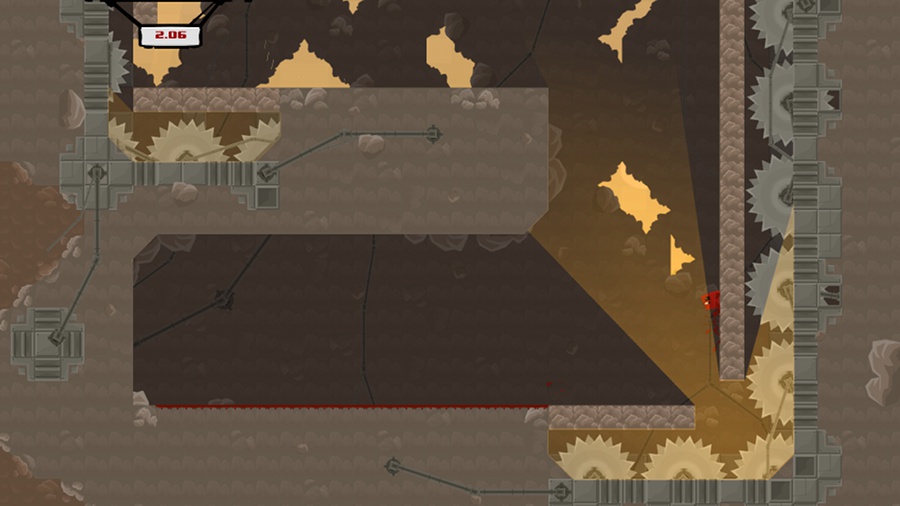
Some people miss that.
Team Meat missed that.
So they made Super Meat Boy.
Super Meat Boy is a throwback in a lot of ways. First, in terms of its difficulty. But most obviously, its art style. It could be described as "relentlessly retro" – the game is firmly grid-based, the pixels are large and chunky, everything about it says "this is a retro game".
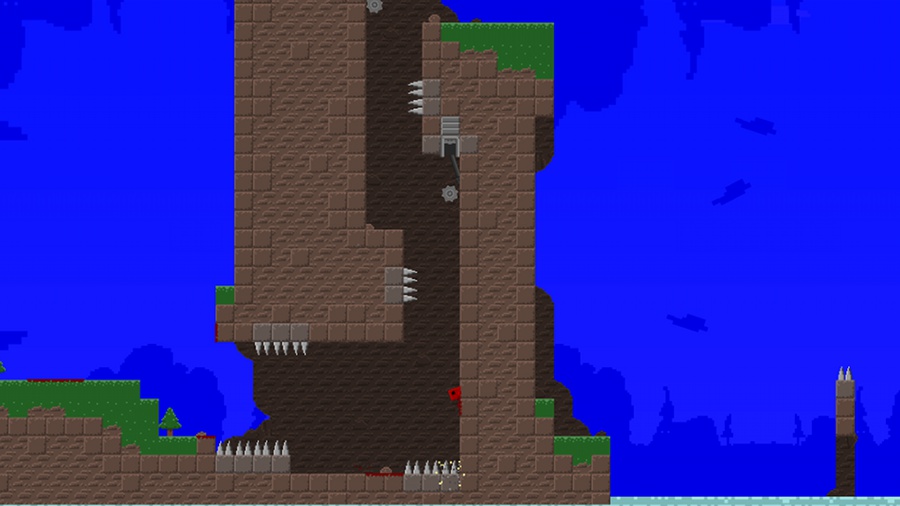
And some parts scream retro. Limited palettes, small assortments of tiles, even less bending of the grid formula. There's slopes in the previous two pictures. There's no slopes here. We don't need slopes. We've got blocks.
What I find most fascinating about Super Meat Boy's art is that it's far, far, far more complex than anything you could do on . . . say . . . a Super Nintendo. Deceptively so. Super Meat Boy's art isn't 16-bit art. It's modern, hardware-accelerated DirectX graphics . . . carefully crafted to be strongly reminiscent of old game consoles, while not actually being old game console art. And curiously, it takes on several "16-bit conventions" that didn't actually exist back in the 16-bit world.
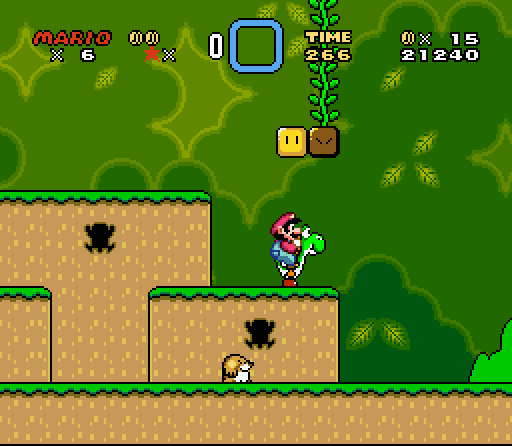
Take a look at an actual 16-bit game, Super Mario World. (In the series Super Mario Brothers. You may notice that Super Meat Boy has the same initials. I would be shocked if this were a coincidence.) Look at what's going on this screeenshot: rounded corners everywhere. The platforms have rounded edges, the blocks are rounded squares. None of that translates into the actual game physics – every ledge behaves like it's a sharp 90 degree angle, the rounding is just there to give it some fancy looks. The floor, and the platforms, have some art going on to give them a little more depth. The background has coloring designed to fake you into thinking it has a lot of depth. Bushes in "front" are darker, bushes in "back" are lighter, and it's all fluffy to make it hard to recognize the tile boundaries.
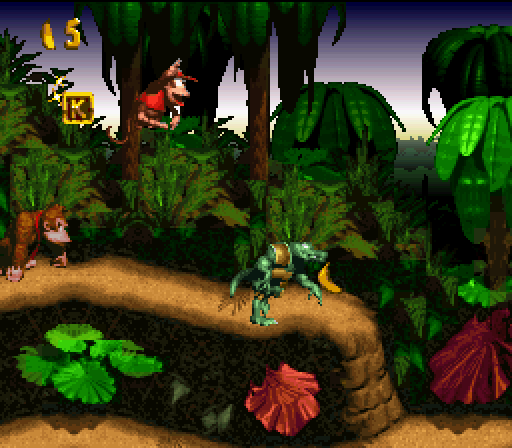

Two more: Donkey Kong Country and Tales of Phantasia. Look at DKC, first. See just how impenetrable the actual level layout is. There's all kinds of crazy fake-perspective and cleverness going on here – you can't even see the underlying grid. This game makes great use of parallax – as you run, the backgrounds scroll at a different rate, to give an impression of depth.
Tales of Phantasia doesn't do as good a job of hiding the grid, but look at how many tricks they're using to make it still look great. Fake 3d, shadows, objects that don't conform to the grid quite like you'd expect. The grid still exists, but the collision layer doesn't conform directly to it – the collision layer is more complex so they can make rough edges. The grid is still there, they just try to hide it. It's all smoke and mirrors.
Super Meat Boy dispenses with the smoke and mirrors. Platforms have hard edges. There's no fake lighting effects on the platforms themselves, just splashes of red where you walked (Super Meat Boy is a boy who has no skin, and as such, he leaves blood everywhere.) There's often multiple layers of background, as you can see in the first image, but there is a hard divide between the "background layers" on the same plane as Super Meat Boy and the background layers deep, deep behind him. The same-plane background scrolls at the same rate as Super Meat Boy does. The deep background layers are much, much, much slower, giving an illusion of depth with no risk of confusion.
The real 16-bit games did everything they could to escape their 16-bit nature. They pulled every graphical trick and programming trick they could. The modern "16-bit" games revel in it. The sharp corners are emphasized instead of hidden. The backgrounds are set apart from the foregrounds.
It's not about immersion, because if they wanted immersion, they wouldn't be making a 16-bit game. It's about a feel and a concept.
The funny part is when they start using techniques that the "16-bit" games couldn't use in the first place.

1: Take a look at the left side of that pipe. You see the tricky thing?
It's rotated.
The Super Nintendo couldn't do that. The Nintendo absolutely couldn't. Easy use of rotation only showed up as of the PSX era, deep into the realism push.
(Okay, the Super Nintendo sort of could, but only one layer out of its 4. It certainly couldn't rotate multiple things independently unless you had a cartridge with special rendering hardware, like Starfox or Yoshi's Island.)
2: The contrast is a little tricky here, but this comes from the third screenshot up above. It's the same deal as #1: rotated clouds. These clouds zip around the level wildly while you're playing. That's not a 16-bit effect, that's a modern hardware accelerator. Can't fool me!
3: Super Meat Boy has some really wonderful lighting effects. In this case, the pit below Meat Boy is emitting light, which is pouring up through the hole and illuminating everything. Again, this is the kind of thing that the classic consoles just couldn't do. Light compositing takes some moderately hefty hardware, and transparencies only showed up in the Super Nintendo era. In this case it's actually even worse than you'd think. The crumbly-looking blocks that Meat Boy is gripping will actually disintegrate after a second or two of being touched, and the lighting effects adjust instantly. That sort of complex lighting is well out of reach of 16-bit consoles, but because it can be easily applied to "16-bit" worlds, and because it looks really quite awesome, it's common in games like this. See Gish for more examples of this lighting style.
(Also not a coincidence – Gish and Super Meat Boy share a substantial portion of their development staff.)
4: You never see old games intentionally making the world blockier than necessary. They do everything they can to make it less blocky. But take a look at this lava – it's obviously and intentionally chunkier than the rest of the level. Big pixels, about twice as large as the pixels on the solid objects, and they're not even grid-aligned. That's not done for the sake of the hardware. That's a pure stylistic choice.
But if you want a really ridiculous example . . .
5: These pixels aren't even square! Look at them! They're ridiculously tall! And I don't even know what's going on with the pixel sizing. On the edge there's tiny, tiny pixels. In the middle there's big chunky pixels. In the fire, there's pixels of all shapes and sizes, glomped together into a flame effect that looks distinctly old-school while having absolutely nothing in common with old-school platform limitations.
The fact that it's sitting on top of a beautiful and completely non-SNES 45 degree angle is just the crowning touch.
Next time you're playing a fake classic game, look at all the tricks they're using to show you how old the game is meant to look. Next time you're playing a real classic game, look at all the tricks they're using to pretend the game has more detail and beauty than it actually does.
This was meant to be one entry. "Oh, but Zorba, it is one entry!" No it's not. You just haven't seen the second part yet. This will be continued.

